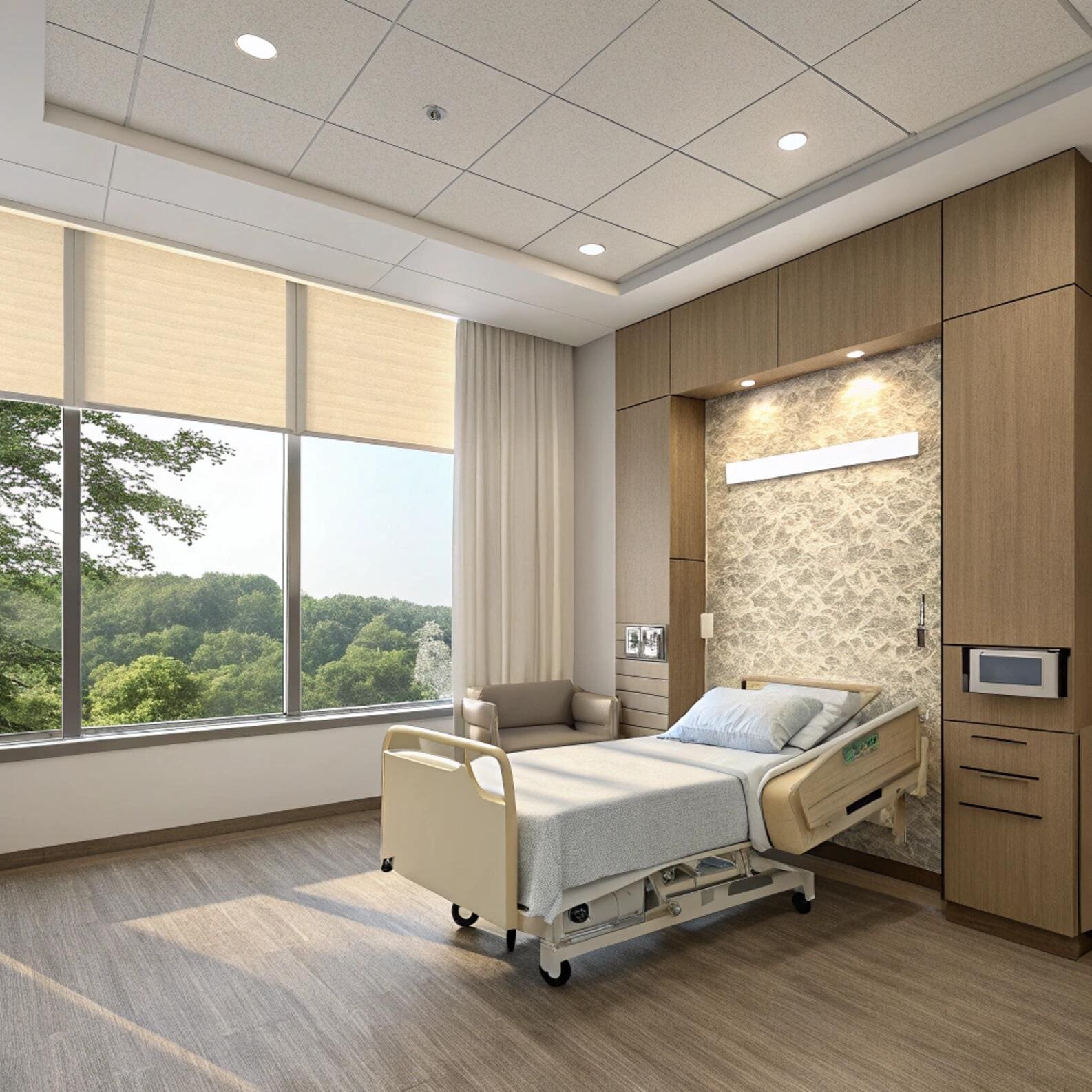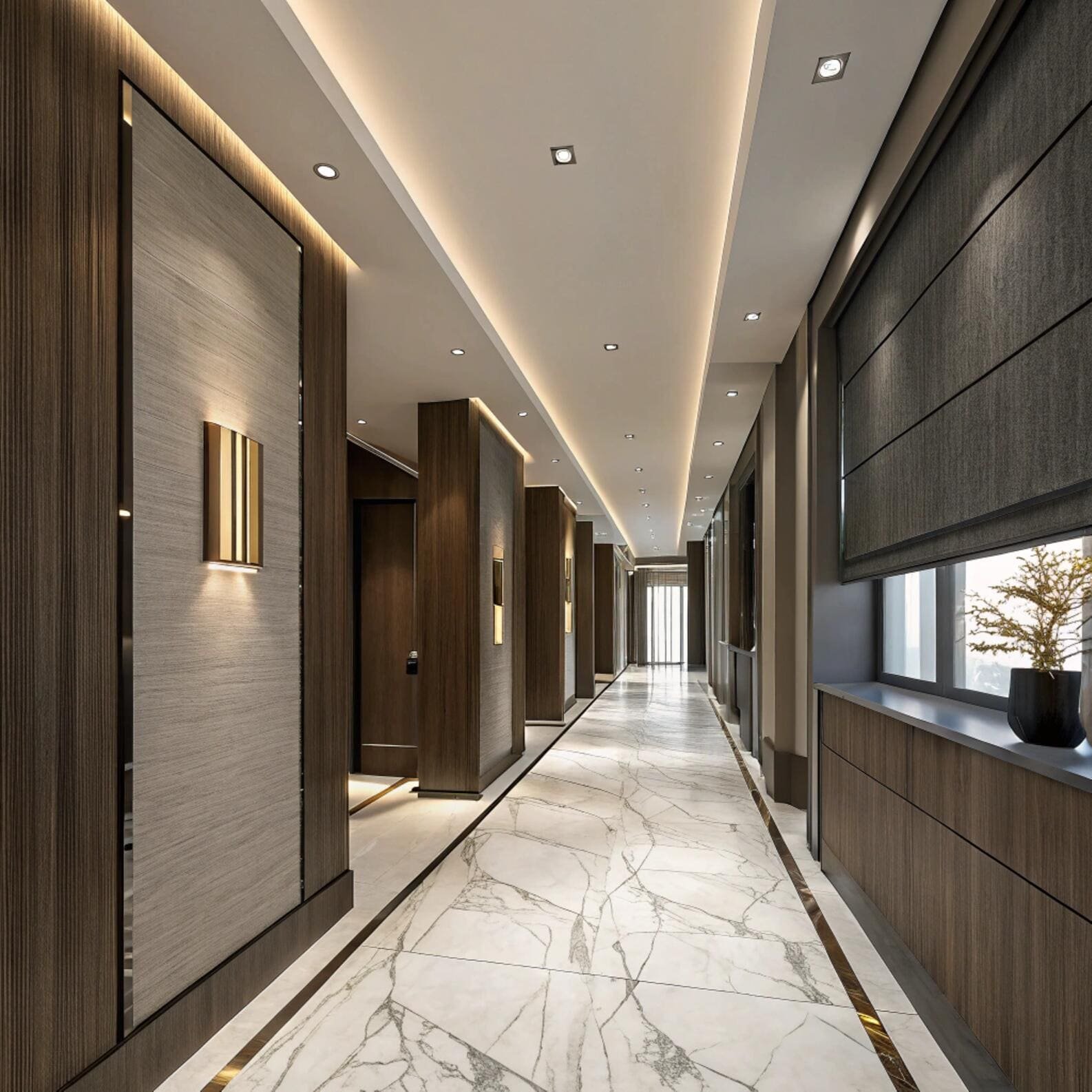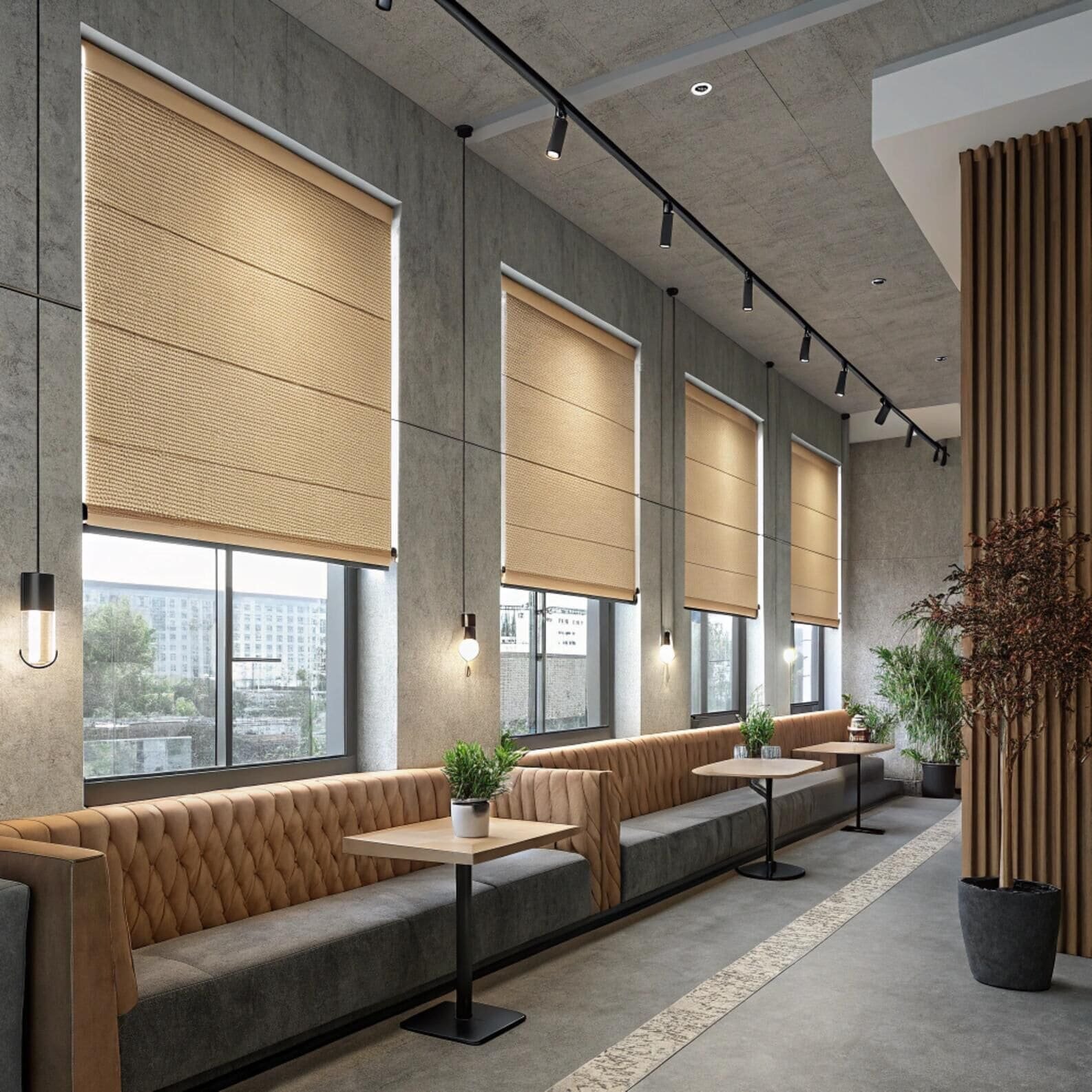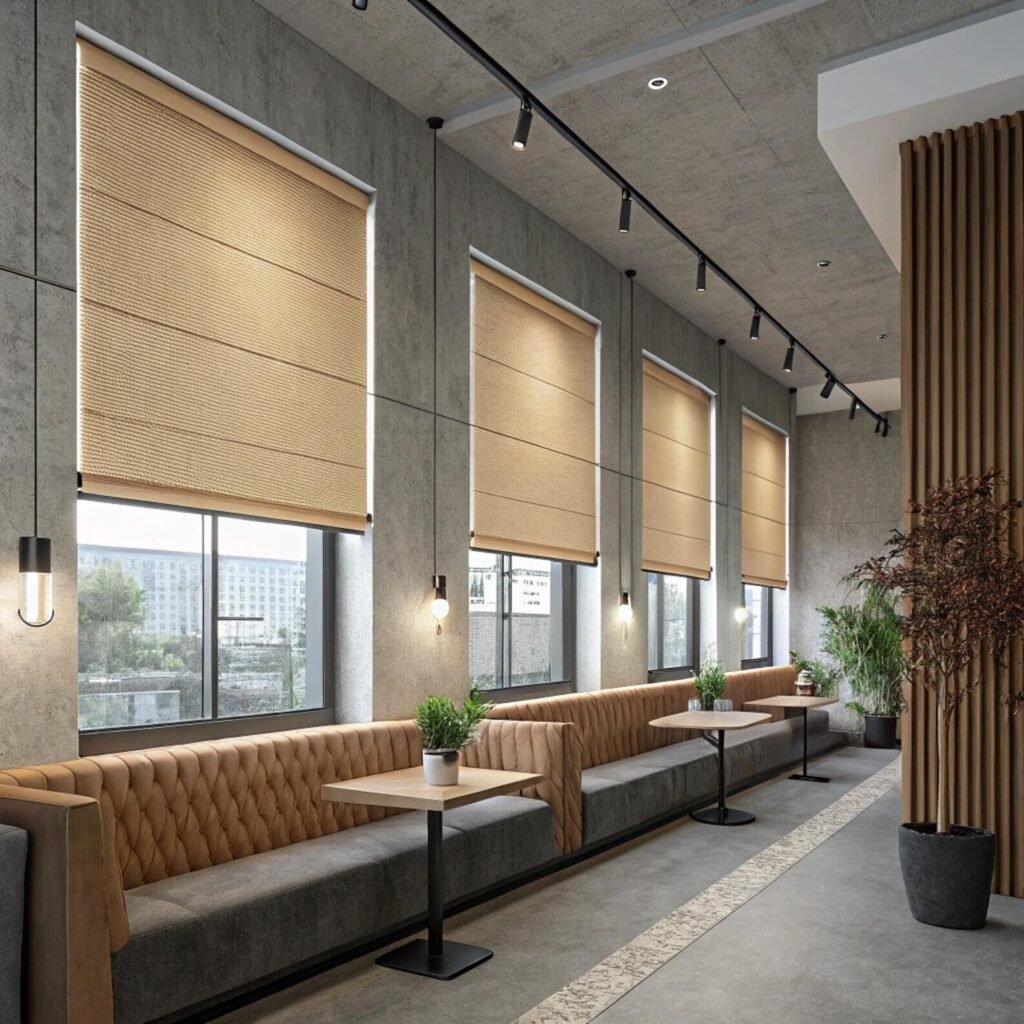Fire safety violations in commercial window treatments expose businesses to liability, insurance issues, and potential catastrophic outcomes. Traditional residential-grade blinds often fail commercial fire safety requirements, creating regulatory compliance gaps.
Fire retardant blinds meet specific commercial safety standards through flame-resistant materials, chemical treatments, and third-party testing certifications required for public buildings, hospitality, healthcare, and educational facilities.

I've navigated fire safety compliance[^1] for over 200 commercial projects across hospitality, healthcare, and educational sectors. Understanding fire retardant requirements prevents costly specification errors and ensures project approval through regulatory inspections.
Are blinds fire retardant?
Standard residential blinds are not inherently fire retardant and require specific materials, treatments, or certifications to meet commercial fire safety requirements. Fire retardant properties depend on fabric composition, chemical treatments, and manufacturing processes.
Most standard blinds are not fire retardant by default - fire resistance requires specific flame-resistant materials, chemical flame retardant treatments, or inherently fire-resistant synthetic compositions meeting commercial safety standards.

Fire Retardant Classification and Commercial Requirements Analysis
Fire retardant blind requirements vary significantly between residential and commercial applications, with commercial installations subject to stringent safety codes that residential applications do not address. My experience with building code compliance across multiple jurisdictions reveals critical distinctions that determine specification requirements and regulatory approval processes.
Commercial Fire Safety Code Requirements: Commercial buildings must comply with International Building Code (IBC), National Fire Protection Association (NFPA) standards, and local fire marshal requirements that specifically address window treatment fire safety. NFPA 701 provides the primary testing standard for flame resistance in curtains, drapes, and window treatments used in commercial environments. Buildings classified as Assembly (Group A), Institutional (Group I), or high-rise commercial structures require window treatments meeting NFPA 701 Method 1 or Method 2 testing standards depending on installation height and building occupancy classifications. Healthcare facilities must additionally comply with CMS (Centers for Medicare & Medicaid Services) requirements that mandate flame-resistant window treatments throughout patient care areas.
Fire Retardant Treatment Classifications: Fire retardant blinds[^2] achieve compliance through three primary approaches - inherently flame-resistant materials, chemical flame retardant treatments applied during manufacturing, or post-manufacturing flame retardant applications. Inherently flame-resistant materials include specific synthetic compositions like modacrylic, aramid fibers, and certain polyester formulations that resist ignition and flame spread without additional chemical treatments. Chemical flame retardant treatments involve application of brominated, phosphorus-based, or nitrogen-containing compounds that interfere with combustion processes at molecular levels. Post-manufacturing treatments apply flame retardant chemicals to finished fabrics through spray, dip, or pressure application methods, though these approaches typically provide shorter-duration protection requiring periodic reapplication.
Testing Standards and Certification Requirements: NFPA 701 testing evaluates fabric flame spread, after-flame time, and char length through standardized vertical and horizontal burn tests that simulate real-world fire exposure conditions. Method 1 testing applies to individual specimens and lighter-weight materials, while Method 2 testing evaluates folded specimens representing multi-layer installations typical in pleated or cellular blind configurations. Acceptable results require after-flame times under 2 seconds, after-glow times under 2 seconds, and char lengths under 6 inches for Method 1, with proportionally adjusted requirements for Method 2 testing. Third-party testing laboratories provide certification documentation required for building permit approval and fire marshal inspections.
| Fire Safety Standard | Application Scope | Testing Requirements | Compliance Documentation |
|---|---|---|---|
| NFPA 701 Method 1 | Individual fabrics | 2-second after-flame limit | Third-party test certificates |
| NFPA 701 Method 2 | Multi-layer assemblies | Folded specimen testing | Laboratory certification reports |
| California Title 19 | Healthcare facilities | Enhanced ignition resistance | State-approved testing results |
| ASTM E84 | Surface burning | Flame spread index ratings | Building code compliance |
Material Composition and Fire Performance: Natural fiber materials including cotton, linen, silk, and jute typically exhibit poor fire resistance without chemical treatments due to cellulose content that readily supports combustion. Synthetic materials demonstrate variable fire performance depending on polymer composition and manufacturing processes. Polyester materials range from highly flammable standard formulations to inherently flame-resistant compositions specifically engineered for commercial fire safety applications. Vinyl and PVC materials generally provide good fire resistance due to chlorine content that inhibits combustion, though some formulations release toxic gases during burning that may violate indoor air quality standards. Metal blinds including aluminum and steel provide excellent fire resistance but may conduct heat during fire exposure, potentially creating different safety concerns.
Installation and Maintenance Considerations: Fire retardant properties require proper installation and maintenance to ensure continued compliance throughout the blind's service life. Chemical flame retardant treatments may degrade through UV exposure, cleaning processes, or environmental conditions, requiring periodic retesting or reapplication to maintain certification status. Professional installation documentation must include fire safety certifications and compliance statements for building permit approval and insurance coverage validation. Maintenance protocols should specify cleaning methods that preserve flame retardant properties and establish inspection schedules for treatment effectiveness evaluation.
Are 100% polyester curtains fire retardant?
Standard 100% polyester curtains are not inherently fire retardant despite synthetic composition. Fire retardant properties require specific polyester formulations, chemical treatments, or manufacturing processes designed for flame resistance rather than standard textile applications.
100% polyester curtains require specific flame-resistant formulations or chemical treatments to achieve fire retardant properties - standard polyester compositions burn readily and do not meet commercial fire safety requirements.

Polyester Fire Performance and Commercial Specification Requirements
Polyester fire performance varies dramatically based on molecular composition, manufacturing processes, and chemical treatments, with standard polyester fabrics presenting significant fire hazards in commercial applications despite common misconceptions about synthetic material fire resistance. Professional specification requires understanding these distinctions to ensure compliance and safety.
Standard Polyester Fire Behavior Characteristics: Conventional 100% polyester fabrics exhibit concerning fire behavior that disqualifies them from commercial fire safety applications without proper treatments. Standard polyester ignites readily when exposed to flame sources, burns rapidly with dripping molten polymer that can spread fire to adjacent materials, and continues burning after flame source removal. The dripping characteristic creates particular hazards as molten polyester adheres to surfaces and continues burning, potentially causing severe injuries and accelerating fire spread. Flame spread rates for untreated polyester fabrics typically exceed 200mm/minute in vertical burn tests, far exceeding NFPA 701 compliance requirements.
Fire Retardant Polyester Formulations: Specialized fire retardant polyester fabrics incorporate flame inhibiting compounds during polymer manufacturing processes rather than surface treatments applied after fabric production. These inherently flame-resistant (IFR) polyester formulations include phosphorus-based additives, brominated compounds, or nitrogen-containing molecules that interfere with combustion chemistry at molecular levels. IFR polyester maintains flame resistance throughout fabric life without degradation from washing, UV exposure, or environmental conditions that affect surface-treated alternatives. Commercial-grade IFR polyester fabrics achieve NFPA 701[^3] compliance with after-flame times under 1 second and minimal char length development.
Chemical Treatment Applications for Standard Polyester: Standard polyester fabrics can achieve fire retardant properties through post-manufacturing chemical treatments, though performance and durability differ significantly from IFR formulations. Phosphorus-based treatments create char formation that insulates underlying fabric from flame exposure, while halogenated compounds release flame-inhibiting gases during combustion. Nitrogen-containing treatments dilute combustible gases and reduce flame intensity. However, chemical treatments require periodic reapplication every 12-24 months depending on environmental exposure and cleaning frequency. Treatment effectiveness decreases over time through normal wear, washing, and UV degradation, potentially creating compliance gaps without regular testing and retreatment schedules.
Testing and Certification Requirements for Polyester Curtains: Commercial polyester curtain installations require third-party NFPA 701 testing certification regardless of manufacturer claims about fire resistance. Testing must evaluate actual fabric samples in final configuration including any pleating, lining, or hardware components that affect fire behavior. Many polyester fabrics that pass initial testing fail retesting after 6-12 months of installation due to treatment degradation or environmental exposure effects. Professional specifications should require annual testing schedules and documentation updates to maintain compliance throughout installation life cycles.
| Polyester Type | Fire Resistance Method | Durability Rating | Compliance Timeline |
|---|---|---|---|
| Standard Polyester | None (flammable) | N/A | Non-compliant |
| Chemically Treated | Surface application | 12-24 months | Requires retesting |
| IFR Polyester | Integral flame resistance | Permanent | One-time certification |
| Coated Polyester | Barrier treatments | Variable | Annual verification |
Performance Comparison and Selection Criteria: IFR polyester provides superior long-term value despite higher initial costs due to permanent flame resistance and eliminated reapplication requirements. Initial costs typically run 40-60% higher than chemically treated alternatives, but lifecycle costs prove lower through eliminated retreatment expenses and reduced testing requirements. Chemical treatment approaches offer lower initial costs but require ongoing maintenance contracts and periodic recertification that may exceed IFR cost savings within 3-5 years. Performance reliability strongly favors IFR formulations for critical applications including healthcare facilities, schools, and high-occupancy buildings where fire safety cannot be compromised by treatment degradation.
Environmental and Health Considerations: IFR polyester formulations generally present fewer environmental and health concerns compared to chemical treatment approaches that may release volatile organic compounds (VOCs) during application and throughout service life. Brominated flame retardants used in some chemical treatments have been associated with environmental persistence and bioaccumulation concerns, leading to regulatory restrictions in certain jurisdictions. Phosphorus-based treatments typically present lower environmental impact but may require more frequent reapplication to maintain effectiveness. Professional specifications should evaluate environmental certifications and indoor air quality impacts when selecting polyester fire retardant approaches for sensitive applications including healthcare and educational facilities.
Is 100% polyester fire retardant safe?
Fire retardant 100% polyester safety depends on treatment methods, chemical compositions, and application environments. Inherently flame-resistant polyester formulations generally provide better safety profiles than chemically treated alternatives, though proper specification requires environmental and health impact evaluation.
Fire retardant 100% polyester safety varies significantly - inherently flame-resistant formulations typically provide superior safety profiles compared to chemically treated alternatives that may release volatile compounds or require toxic flame retardant chemicals.

Comprehensive Safety Assessment for Fire Retardant Polyester Applications
Fire retardant polyester safety evaluation requires analysis of manufacturing processes, chemical compositions, environmental impacts, and long-term health effects that vary dramatically between treatment approaches and formulation methods. Professional specification decisions must balance fire safety requirements with occupant health and environmental considerations.
Chemical Safety Profiles of Different Treatment Methods: Inherently flame-resistant (IFR) polyester incorporates flame retardant compounds during polymer manufacturing, creating chemically stable molecular structures that minimize ongoing chemical exposure throughout fabric life. IFR formulations typically utilize phosphorus-based compounds, nitrogen-containing additives, or specialized polymer modifications that achieve flame resistance without halogenated chemicals associated with health concerns. Chemical stability prevents migration of flame retardant compounds from fabric fibers, reducing occupant exposure through air emissions or direct contact. Independent testing demonstrates minimal volatile organic compound (VOC) emissions from IFR polyester installations, supporting indoor air quality objectives for sensitive applications.
Chemical Treatment Safety Concerns and Mitigation: Post-manufacturing chemical flame retardant treatments present variable safety profiles depending on specific compounds used and application methods employed. Brominated flame retardants historically used in textile treatments have been associated with environmental persistence, bioaccumulation potential, and endocrine disruption concerns, leading to regulatory restrictions and phase-out initiatives in many jurisdictions. Organophosphate flame retardants may release volatile compounds during installation and throughout service life, potentially contributing to indoor air quality degradation. However, newer phosphorus-based treatments utilize less volatile formulations with improved safety profiles while maintaining effective flame resistance. Professional specifications should require safety data sheets (SDS) and third-party environmental testing for all chemical treatment approaches.
Indoor Air Quality Impacts and Mitigation Strategies: Fire retardant polyester installations can impact indoor air quality through chemical emissions, particularly during initial installation periods and elevated temperature conditions. Off-gassing patterns vary significantly between treatment methods, with chemical treatments typically producing higher emission levels compared to IFR formulations. Professional installations should include ventilation considerations and emission testing protocols for sensitive applications including healthcare facilities, schools, and residential environments with occupants having chemical sensitivities. Low-emission certification programs such as GREENGUARD provide third-party verification of acceptable emission levels for commercial indoor air quality standards.
Long-term Health and Environmental Considerations: Lifecycle safety assessment must consider disposal impacts, recycling possibilities, and long-term environmental effects of different fire retardant approaches. IFR polyester typically presents fewer end-of-life environmental concerns due to chemically stable formulations that prevent leaching during disposal processes. Chemical treatments may require special disposal procedures to prevent environmental contamination, particularly for halogenated compounds restricted under environmental regulations. Recycling possibilities vary significantly, with IFR formulations often compatible with standard polyester recycling streams while chemically treated fabrics may require specialized processing or disposal methods.
| Safety Factor | IFR Polyester | Chemical Treatment | Risk Assessment |
|---|---|---|---|
| VOC Emissions | Minimal | Variable | Indoor air quality impact |
| Chemical Migration | None | Possible | Direct exposure risk |
| End-of-life Safety | Standard disposal | Special handling | Environmental impact |
| Regulatory Compliance | Generally compliant | Jurisdiction dependent | Legal liability |
Regulatory Compliance and Liability Considerations: Fire retardant polyester safety requirements vary by jurisdiction, with some regions implementing restrictions on specific flame retardant chemicals based on health and environmental concerns. California Proposition 65 requires disclosure of certain flame retardant chemicals in consumer products, while European REACH regulations restrict or ban specific brominated compounds. Professional specifications must verify regulatory compliance for installation jurisdictions and consider potential future restrictions that could affect long-term viability. Insurance and liability considerations may favor IFR formulations due to reduced chemical exposure risks and improved regulatory compliance profiles.
Application-Specific Safety Recommendations: Healthcare facilities require particular attention to chemical safety due to vulnerable patient populations and indoor air quality sensitivities. IFR polyester formulations typically provide optimal safety profiles for patient care areas while maintaining fire safety compliance. Educational applications benefit from low-emission approaches that support learning environment quality and minimize chemical exposure risks for developing children. Commercial office environments should balance fire safety requirements with employee health considerations and productivity impacts from indoor air quality degradation. Residential applications in commercial buildings such as hotels or assisted living facilities require careful evaluation of occupant exposure risks and comfort considerations.
What fabric is completely fireproof?
No fabric is completely fireproof - all materials will eventually burn under sufficient heat exposure. However, certain materials provide exceptional fire resistance, including glass fiber, ceramic fiber, carbon fiber, and specialized metal fiber composites that resist ignition and limit flame spread.
No fabric achieves complete fireproof status, but glass fiber, ceramic fiber, carbon fiber, and metal fiber composites provide maximum fire resistance for extreme applications requiring superior flame protection beyond standard commercial requirements.

Ultra-High Performance Fire Resistant Materials for Extreme Applications
Understanding maximum fire resistance capabilities enables proper material selection for applications requiring performance beyond standard commercial fire retardant requirements. My experience with extreme-environment installations including industrial facilities, aerospace applications, and specialized safety equipment provides insight into ultimate fire resistance possibilities and practical limitations.
Glass Fiber and Ceramic Compositions: Glass fiber fabrics provide exceptional fire resistance through inorganic composition that resists ignition and maintains structural integrity at temperatures exceeding 1000°F (538°C). Glass fiber window treatments remain dimensionally stable during fire exposure without melting, dripping, or contributing to flame spread, making them suitable for industrial applications with extreme fire safety requirements. However, glass fiber presents handling challenges due to potential skin and respiratory irritation from fiber particles, requiring protective equipment during installation and maintenance. Ceramic fiber compositions achieve even higher temperature resistance, maintaining integrity at temperatures above 2000°F (1093°C), but extreme brittleness and health concerns limit practical window treatment applications.
Carbon Fiber and Advanced Synthetic Options: Carbon fiber fabrics provide excellent fire resistance combined with superior durability and aesthetic possibilities for high-performance applications. Carbon fiber resists ignition, produces minimal smoke during fire exposure, and maintains structural properties at elevated temperatures. However, carbon fiber costs typically exceed glass fiber alternatives by 300-500%, limiting applications to specialized requirements where performance justifies premium investment. Advanced aramid fibers including Nomex and Kevlar provide excellent fire resistance with improved handling characteristics compared to glass fiber, though costs remain substantially higher than standard fire retardant treatments.
Metal Fiber Composite Systems: Stainless steel fiber fabrics and aluminum-coated compositions provide exceptional fire resistance while maintaining flexibility for window treatment applications. Metal fiber systems resist ignition, reflect radiant heat, and provide electromagnetic shielding benefits in sensitive applications. Stainless steel compositions maintain fire resistance indefinitely without degradation from environmental exposure or cleaning processes. However, weight considerations, cost premiums, and aesthetic limitations restrict metal fiber applications to specialized industrial or high-security installations where maximum fire protection justifies functional compromises.
Practical Limitations and Application Considerations: Even maximum fire resistance materials eventually fail under extreme heat exposure or direct flame contact over extended periods. Professional fire safety planning must include evacuation procedures, sprinkler systems, and comprehensive fire prevention measures rather than relying solely on material fire resistance. Ultra-high performance materials typically require specialized installation techniques, maintenance procedures, and safety protocols that exceed standard window treatment requirements. Cost analysis must consider complete system requirements including installation complexity, maintenance demands, and lifecycle performance to evaluate practical viability.
| Material Type | Temperature Resistance | Fire Performance | Practical Limitations |
|---|---|---|---|
| Glass Fiber | 1000°F+ (538°C+) | Excellent | Handling safety concerns |
| Ceramic Fiber | 2000°F+ (1093°C+) | Superior | Brittleness and health risks |
| Carbon Fiber | 1200°F+ (649°C+) | Excellent | Premium cost requirements |
| Metal Fiber | Variable by alloy | Superior | Weight and aesthetic limits |
Cost-Benefit Analysis for Extreme Fire Resistance: Ultra-high performance fire resistant materials typically cost 500-1000% more than standard fire retardant alternatives, requiring careful justification through risk analysis and regulatory requirements. Industrial applications with exposure to high-temperature processes, chemical hazards, or explosion risks may justify premium materials through insurance reductions, regulatory compliance, and liability mitigation. Most commercial applications achieve adequate fire safety through standard NFPA 701 compliant materials without requiring extreme performance levels. Professional risk assessment should evaluate specific hazard exposures, evacuation capabilities, and comprehensive fire safety systems to determine appropriate material performance levels and cost-effective solutions.
How can you tell if fabric is fire retardant?
Fire retardant fabric identification requires examination of labels, certifications, testing documentation, and physical characteristics. Professional verification involves third-party testing certificates, manufacturer specifications, and compliance documentation rather than visual inspection alone.
Fire retardant fabric verification requires checking certification labels, third-party test documentation, manufacturer specifications, and compliance certificates - visual inspection alone cannot reliably determine fire retardant properties or regulatory compliance status.

Professional Fire Retardant Verification and Compliance Documentation
Proper fire retardant fabric identification prevents costly specification errors and ensures regulatory compliance through systematic verification procedures that extend beyond visual inspection to include documentation review and testing validation. My experience with building code compliance and fire marshal inspections reveals critical identification methods that ensure project approval and long-term compliance.
Certification Label Requirements and Interpretation: Legitimate fire retardant fabrics must display permanent labels indicating compliance with specific fire safety standards, typically including NFPA 701, California Title 19, or international equivalents depending on manufacturing origin and intended applications. Labels should specify testing standard compliance, certification date, and testing laboratory identification for verification purposes. Permanent labeling typically involves woven tags, printed information directly on fabric edges, or heat-sealed labels that cannot be easily removed without fabric damage. Temporary stickers or removable tags do not constitute adequate certification documentation for commercial applications requiring regulatory compliance verification.
Third-Party Testing Documentation Requirements: Professional fire retardant verification requires current third-party testing certificates from accredited laboratories demonstrating compliance with applicable fire safety standards. Test certificates must include specific fabric identification, testing methodology, quantitative results, and certification validity periods. Many chemical flame retardant treatments require annual retesting to verify continued effectiveness, with certificates indicating testing frequency requirements and expiration dates. Professional installations should maintain complete testing documentation files for building permit approval, fire marshal inspections, and insurance coverage validation throughout the installation's service life.
Physical Characteristics and Inspection Methods: Fire retardant fabrics often exhibit subtle physical characteristics that distinguish them from standard materials, though these indicators require professional experience for reliable interpretation. IFR (inherently flame resistant) synthetic fabrics may feel slightly stiffer or have different texture compared to standard formulations due to flame retardant compound integration. Chemically treated fabrics sometimes exhibit slight chemical odors, particularly when new, though odor intensity varies by treatment method and may dissipate over time. However, physical characteristics alone cannot reliably determine fire retardant properties or compliance status without supporting documentation and testing verification.
Professional Testing and Verification Procedures: When fire retardant status remains uncertain or documentation is unavailable, professional testing provides definitive verification through controlled burn tests following NFPA 701 protocols. Professional testing involves small fabric samples subjected to standardized flame exposure with measurement of after-flame time, after-glow duration, and char length development. Testing must be performed by qualified laboratories with appropriate equipment and certification to provide legally acceptable results for regulatory compliance. Field testing methods using lighters or matches provide unreliable results and may damage valuable fabric samples without producing valid compliance verification.
| Identification Method | Reliability Level | Professional Use | Regulatory Acceptance |
|---|---|---|---|
| Certification Labels | High | Primary verification | Required for compliance |
| Test Certificates | Highest | Documentation proof | Essential for permits |
| Physical Inspection | Low | Preliminary assessment | Insufficient alone |
| Professional Testing | Highest | Definitive verification | Legally acceptable |
Common Identification Mistakes and Avoidance Strategies: Fabric retailers and distributors sometimes make unsubstantiated fire retardant claims without proper certification, creating specification errors and compliance violations. Professional verification requires independent documentation review rather than relying on sales representations or product literature claims. Imported fabrics may have foreign certifications that do not meet local fire safety requirements, requiring additional testing or recertification for compliance. Aged fire retardant treatments may have expired effectiveness without visible deterioration, emphasizing the importance of current testing documentation and periodic verification schedules.
Documentation Management and Compliance Tracking: Professional installations require comprehensive documentation management systems that track certification validity, testing schedules, and compliance status throughout fabric service life. Digital documentation systems should include searchable certification databases, expiration date alerts, and maintenance schedule tracking to prevent compliance gaps. Regular documentation audits verify continued certification validity and identify fabrics requiring retesting or treatment renewal. Professional maintenance contracts should include documentation management services and compliance tracking to ensure continued regulatory approval and insurance coverage validity.
Quality Assurance and Installation Verification: Fire retardant fabric installation should include quality assurance procedures that verify specification compliance and proper handling throughout the installation process. Installation teams must maintain fabric identification throughout delivery and installation to prevent mixing with non-compliant materials. Final installation documentation should include fabric certification verification, compliance photographs, and professional installer certifications required for warranty activation and regulatory approval. Quality assurance procedures help prevent costly remediation requirements and ensure long-term compliance with fire safety regulations.
Conclusion
Fire retardant blinds require careful specification, proper certification verification, and ongoing compliance management to meet commercial safety standards while balancing performance, cost, and environmental considerations for successful project outcomes.
Extended FAQ Section
What fire safety standards apply to commercial blind installations?
Commercial blind installations must comply with International Building Code (IBC) requirements, NFPA 701 flame resistance standards, and local fire marshal regulations that vary by building occupancy classification and installation height. Assembly buildings (Group A) including theaters, restaurants, and meeting halls require NFPA 701 compliant window treatments throughout public areas, with Method 1 testing for individual fabrics and Method 2 testing for multi-layer installations. Institutional buildings (Group I) such as hospitals, schools, and care facilities require enhanced fire safety compliance including CMS requirements for healthcare facilities that mandate flame-resistant window treatments in patient care areas. High-rise buildings typically require NONFPA 701 compliance for all window treatments above 75 feet in height, regardless of occupancy classification. Educational facilities must meet state-specific requirements that often exceed basic IBC standards, with many jurisdictions requiring California Title 19 compliance for enhanced flame resistance. Healthcare facilities face the most stringent requirements, including CMS Conditions of Participation that mandate flame-resistant window treatments meeting NFPA 701 standards throughout patient care areas, corridors, and exit routes. Professional specifications must verify applicable standards for specific building types, occupancy classifications, and local jurisdictions before material selection and installation. Fire marshal inspections require current third-party testing certificates, proper labeling, and installation documentation that demonstrates compliance with applicable standards. Insurance requirements may impose additional fire safety standards beyond minimum code requirements, particularly for high-value properties or specialized occupancy types requiring enhanced loss prevention measures.
How often do fire retardant treatments need renewal or retesting?
Fire retardant treatment renewal and retesting requirements depend on treatment type, environmental exposure, and regulatory jurisdiction, with chemical treatments typically requiring annual verification while inherently flame-resistant materials need only initial certification. Chemical flame retardant treatments applied to standard fabrics degrade through UV exposure, cleaning processes, and environmental conditions, requiring retesting every 12-24 months to verify continued effectiveness and regulatory compliance. Professional testing schedules should account for installation environment factors including solar exposure, humidity levels, and cleaning frequency that accelerate treatment degradation. Healthcare facilities often require more frequent testing due to intensive cleaning protocols and chemical exposure that may affect flame retardant effectiveness. Educational environments may require testing before each school year to ensure compliance throughout occupancy periods. Inherently flame-resistant (IFR) materials maintain fire resistance throughout fabric life without degradation, requiring only initial certification and periodic documentation verification rather than performance retesting. However, IFR installations should undergo visual inspection annually to verify fabric integrity and identify any damage that could compromise fire performance. Professional maintenance contracts typically include testing schedule management, documentation tracking, and compliance verification services that ensure continued regulatory approval without operational disruptions. Treatment renewal involves reapplication of flame retardant chemicals through spray, dip, or pressure application methods performed by certified applicators using approved chemical formulations. Renewal costs typically range from 40-60% of original treatment costs, making lifecycle cost analysis important for budgeting decisions. Documentation management requires tracking certification expiration dates, scheduling retesting appointments, and maintaining current compliance certificates for regulatory inspections and insurance coverage validation. Professional installations should establish preventive maintenance schedules that include treatment effectiveness monitoring and proactive renewal planning to prevent compliance gaps.
What are the cost differences between fire retardant and standard commercial blinds?
Fire retardant blind costs typically exceed standard commercial alternatives by 50-200% depending on treatment method, certification requirements, and performance specifications, with inherently flame-resistant materials commanding premium pricing but offering superior long-term value. Basic chemical fire retardant treatments add $15-30 per square foot to standard blind costs, while inherently flame-resistant fabrics increase costs by $25-50 per square foot compared to standard commercial-grade materials. Professional installation costs increase 20-40% due to documentation requirements, certification verification, and specialized handling procedures required for fire retardant materials. Third-party testing and certification add $200-500 per fabric type for initial compliance verification, with ongoing retesting costs of $150-300 annually for chemically treated materials. However, lifecycle cost analysis often favors fire retardant specifications through reduced insurance premiums, regulatory compliance benefits, and elimination of costly remediation requirements from non-compliant installations. Insurance premium reductions of 5-15% are common for buildings with comprehensive fire safety measures including compliant window treatments, providing annual savings that offset specification cost premiums over 3-5 year periods. Regulatory compliance costs including permit fees, inspection charges, and documentation requirements add $100-300 per project but prevent costly violation fines and installation delays that exceed compliance investment. Professional specification services for fire retardant compliance typically cost $500-1500 per project but prevent specification errors that could require complete reinstallation at full project cost. Maintenance cost differences vary by treatment type, with chemical treatments requiring annual renewal expenses of $5-15 per square foot while IFR materials need only standard cleaning and inspection. Project-level cost analysis must consider total fire safety system integration, regulatory compliance benefits, insurance implications, and long-term maintenance requirements to properly evaluate fire retardant specification value propositions and return on investment calculations.
Ensure Fire Safety Compliance for Your Next Project
Don't risk regulatory violations or safety liability with non-compliant window treatments. Our fire safety specialists provide comprehensive compliance consulting, certified material specification, and professional installation services that meet all commercial fire safety requirements.
Get detailed fire safety compliance analysis, certified material specifications, and regulatory documentation support by contacting info@velablinds.com today.
---
[^1]: Discover effective strategies for maintaining fire safety compliance in your business's window treatments, safeguarding against risks and liabilities.
[^2]: Explore this link to understand how fire retardant blinds can enhance safety and compliance in commercial environments, protecting your business from potential liabilities.
[^3]: Learn about NFPA 701 standards to ensure your window treatments meet essential fire safety requirements, crucial for regulatory compliance.Partner with VelaBlinds for Your Next Project
Smart window treatments shouldn't be complicated. After working with 500+ distributors and contractors worldwide, I've streamlined the process to get you quality products, competitive pricing, and reliable support - every time.
Why project professionals choose VelaBlinds:
- ✅ Fast, Accurate Quotes - Detailed specs and pricing within 24 hours
- ✅ Transparent Pricing - No hidden fees, volume discounts clearly outlined
- ✅ Quality Assurance - Direct partnerships with certified OEM manufacturers
- ✅ Project Support - Dedicated account manager from quote to delivery
Start your next project:
📧 Quick Quote: Send your requirements to info@velablinds.com
📱 Direct Contact: WhatsApp +86 137 2012 8317
🌐 Browse Solutions: https://velablinds.com/
📁 Product Resources: Access spec sheets, catalogs & project files
Jimmy Chen, Founder
"I built VelaBlinds to solve the real challenges I faced as a project buyer - long lead times, unclear specs, and unreliable suppliers. Let's discuss how we can power your projects with smarter blinds."
Serving distributors and contractors across North America, Europe, and Australia since 2018.




